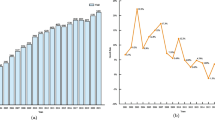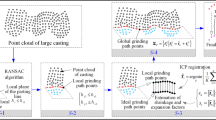Abstract
Large and complex forgings, serving as key load-supporting components in the fields of energy, ships, transportation, etc., require high dimensional accuracy and surface quality during post-processing. The automation of grinding for such large and complex forgings presents a common and pressing challenge within the forging industry. One of the main obstacles lies in the substantial thermal deformation and various random forging defects, making the automatic generation of grinding paths a difficult task. Here we propose an algorithm for identifying random defects in large and complex forgings. By combining the RANdom Sample Consensus (RANSAC) algorithm with the Modified Iterative Closest Point (M-ICP) algorithm, we register the standard component point cloud with the forging point cloud, thereby obtaining the point cloud representing the random defects that have to be ground. Subsequently, we classify the random defect point cloud based on defect area size and establish an intelligent strategy for generating grinding paths. Utilizing the positional coordinate information within the random defect point cloud, we directly generate robot grinding paths without relying on a CAD model. Finally, we conduct robot grinding experiments on a large and complex forging. The experimental results demonstrate that the model-free generation method for grinding paths accurately identifies the characteristics of random forging defects, efficiently plans robot grinding paths, and significantly improves grinding efficiency and quality. This approach offers an intelligent solution for the post-processing of large and complex forgings.













Similar content being viewed by others
Data availability
The data and materials underlying this article will be shared on reasonable request to the corresponding author.
Code availability
The code underlying this article will be shared on reasonable request to the corresponding author.
References
Kafle A, Shrestha PL, Chitrakar S, Thapa B, Thapa BS, Sharma N (2020) A review on casting technology with the prospects on its application for hydro turbines [J]. J Phys Conf Ser 1608:1
Prabhakar P, Salonitis JM (2020) Minimising defect formation in sand casting of sheet lead: a DoE approach [J]. Metals-Open Access Metall J 10(2):252
Zhang M, Chen T, Tan Y, Lu J (2020) An adaptive grinding method for precision-cast blades with geometric deviation[J]. Int J Adv Manuf Technol 108:2349–2365
Zhao X, Tao B, Ding H (2021) Multi-mobile robot cluster system for robot machining of large-scale workpieces[J]. IEEE/ASME Trans Mechatron 27(1):561–571
Wang J, Tao B, Gong Z, Yu W, Yin Z (2021) A mobile robotic 3-D measurement method based on point clouds alignment for large-scale complex components[J]. IEEE Trans Instrum Meas 67:102010
**ao W, Liu G, Zhao G (2021) Generating the tool path directly with point cloud for aero-engine blades repair[J]. Proc Inst Mech Eng 235:5
Di D, Polden J, Dong J, Tao PY (2018) Sensor guided robot path generation for surface repair tasks on a large scale buoyancy module[J]. IEEE/ASME Trans Mechatronics 23:636–645
Liu T, Yang ZH, Hu S, Zhang Z, **ao C, Guo X, Yang L. Neighbor reweighted local centroid for geometric feature identification[J]. IEEE Trans Vis Comput Grap 29(2):1545–1558
Gao Y, Zhang Y (2022) Automatic recognition of machining features based on deep learning of machining surface point cloud data[J]. Comput Syst Appl 31(2):143–149
Lu WX, **ong RP (2022) Point cloud registration based on feature attribute matching [J]. Modular Mach Tool Autom Manuf Tech 04:32–35
Yan S X, Wang Q l, Su P, Wang W (2021) An intelligent path Generation method of robotic grinding for large forging parts. Intell Robot Appl. 13015
Ma K, Han L, Sun X, Liang C, Zhang S, Shi Y, Wang X (2020) A path planning method of robotic belt grinding for workpieces with complex surfaces[J]. IEEE/ASME Trans Mechatron 25(2):728–738
Wang W, Yun C (2011) A path planning method for robotic belt surface grinding[J]. Chin J Aeronaut 24(004):520–526
Lv Y, Peng Z, Qu C, Zhu D (2020) An adaptive trajectory planning algorithm for robotic belt grinding of blade leading and trailing edges based on material removal profile model[J]. Robot Comput-Integr Manuf 66:101987
Wang W, Liu F, Liu Z, Yun C (2017) Prediction of depth of cut for robotic belt grinding[J]. Int J Adv Manuf Technol 91(1–4):699–708
Jia H, Lu XH, **ang Y, Chen J, Bao C (2023) Predictive modeling and analysis of material removal characteristics for robotic belt grinding of complex blade. Appl Sci 13(7):4248
Zhu G, Cai M, Wang Z, Li L, Zhao J, Zhou B (2023) A new calibration method for a dynamic coordinate system in a robotic blade grinding and polishing system based on the six-point limit principle[J]. Robot Comput-Integr Manuf 83:102561
Wu ZW, Fan WG, Qian C, Hou G (2023) Contact mechanism of rail grinding with open-structured abrasive belt based on pressure grinding plate. Chinese J Mech Eng 36:1
Huang XK, Chai Z, Du X, Chen X, Chai Z, Chen X (2024) Partitioned abrasive belt condition monitoring based on a unified coefficient and image processing[J]. J Intell Manuf 35:905–923
**ao GJ, Chen SL, Song K, Liu X, Huang Y (2022) A novel trajectory planning method based on reverse compensation of profile error for robotic belt grinding of blisk[J]. J Manuf Proc 84:508–521
Joshi K, Melkote SN, Chaudhari R (2021) Investigation of cycle time behavior in the robotic grinding process[J]. CIRP J Manuf Sci Technol 35:315–322
Yue Y, Zhang JB, Zhou Y, Wen K, Yang J, Chen Q, Bai X (2021) Inverse input prediction model for robotic belt grinding[J]. Int J Intelli Robot Appl 5:4
Wang NN, Zhang GP, Ren L, Pang W, Wang Y (2021) Vision and sound fusion-based material removal rate monitoring for abrasive belt grinding using improved LightGBM algorithm[J]. J Manuf Proc 66:281–292
Qu C, Lv YJ, Yang ZY, Xu X, Zhu D, Yan S (2019) An improved chip-thickness model for surface roughness prediction in robotic belt grinding considering the elastic state at contact wheel-workpiece interface[J]. Int J Adv Manuf Technol 104:5–8
Cheng XJ, Jia DF, Cheng XL (2014) Theory and technology of massive point cloud data processing [M]. Tongji University Press, Shanghai
Zhao T, Li H, Cai Q, Cao Q (2016) Point cloud segmentation based on FPFH features[C]. In: Proceedings of 2016 Chinese Intelligent Systems Conference(CISC 2016), **amen, China, pp 427–436
Rusu RB, Blodow N, Beetz M (2009) Fast point feature histograms (FPFH) for 3D registration[C]. In: Proceedings 2009 IEEE International Conference on Robotics and Automation(ICRA), Kobe, Japan, pp 3212–3217
Li S, Wang J, Liang Z, Su L (2016) Tree point clouds registration using an improved ICP algorithm based on kd-tree[C]. In: Proceedings of 2016 IEEE International Geoscience and Remote Sensing Symposium (IGARSS), Bei**g, China, pp 4545–4548
Acknowledgements
This study was funded by Defense Industrial Technology Development Program of China under Grant NO. JCKY2021204B045. We are sincerely grateful for their generous support.
Funding
This study was funded by Defense Industrial Technology Development Program of China under Grant NO. JCKY2021204B045.
Author information
Authors and Affiliations
Contributions
The corresponding author of the manuscript is responsible for the content of the submitted manuscript, as well as for the modification, Q&A, and proofreading of the paper or design work. He/she is responsible for sending and receiving review and layout fees, sample publications, and remuneration. He/she is also responsible for any withdrawal of the manuscript due to any reason (but after paying the layout fee, the manuscript cannot be withdrawn, otherwise the layout fee will not be refunded), and is responsible for all other matters related to the manuscript. For papers signed by multiple authors, the authors guarantee that the content, order, and unit content and order of the signatures are not disputed.
Corresponding author
Ethics declarations
Ethics approval
All authors guarantee the legality of the paper or design work, that is, there is no academic misconduct such as plagiarism, plagiarism, infringement, data and image forgery, and it does not involve national or relevant unit secrets. Any economic losses and social adverse effects caused by bad behavior shall be the responsibility of the author himself.
Consent to participate
If the author has not made serious modifications to the manuscript or has no conditions to make corresponding modifications to the article, the editorial department has the right to unilaterally make final editorial modifications to the author's revised manuscript based on the modification opinions (including deleting some content).
Consent for publication
After the manuscript is accepted for publication, all authors agree to transfer the publication rights of the article to The International Journal of Advanced Manufacturing Technology editorial department for exclusive use, including print, CD, and online versions, and agree that the editorial department will uniformly include it in the relevant database retrieval system.
Conflict of interest
The authors declare no competing interests.
Additional information
Publisher's Note
Springer Nature remains neutral with regard to jurisdictional claims in published maps and institutional affiliations.
Supplementary Information
Below is the link to the electronic supplementary material.
Rights and permissions
Springer Nature or its licensor (e.g. a society or other partner) holds exclusive rights to this article under a publishing agreement with the author(s) or other rightsholder(s); author self-archiving of the accepted manuscript version of this article is solely governed by the terms of such publishing agreement and applicable law.
About this article
Cite this article
Yan, S., Wang, W., Su, P. et al. Point cloud-based model-free path planning method of robotic grinding for large complex forged parts. Int J Adv Manuf Technol (2024). https://doi.org/10.1007/s00170-024-13844-w
Received:
Accepted:
Published:
DOI: https://doi.org/10.1007/s00170-024-13844-w




